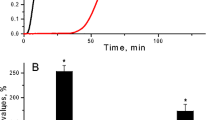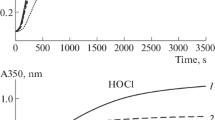Abstract
The aim was to relate fibrin structure and the stimulatory effect of fibrin on plasminogen activation during t-PA-mediated fibrinolysis using Lys78-plasminogen as activator substrate. Structural studies were undertaken by static and dynamic laser light scattering, cryo transmission electron microscopy and by the measurement of conversion of fibrin to X-, Y- and D-fragments. The kinetics of plasmin formation were monitored by measurement of the rate of pNA-release from Val-LeuLys-pNA. The process of fibrin formation and degradation comprised three phases. In the first phase, protofibrils with an average length of about 10 times that of fibrinogen were formed. The duration of this phase decreased with increasing t-PA concentration. The second phase was characterized by a sudden elongation and lateral aggregation of fibrin fibers, most pronounced at low levels of t-PA, and by formation of fragment X-polymer. The third phase was dominated by fragmentation of fibers and by formation of Y- and D-fragments: Plasmin degraded the fibers from within, resulting in the formation of long loose bundles, which subsequently disintegrated into thin filaments with a length of less than 10 and a mass per length close to one relative to fibrinogen. Plasmin generation at high t-PA concentrations sets in just prior to (and at low t-PA concentrations shortly after) the onset of the rapid second phase of elongation and lateral aggregation of fibrin fibers. The maximal rate of plasmin formation per mol t-PA was the same at all concentrations of activator and was achieved close to the time of the peak level of fragment X-polymer. Plasmin formation ceased after formation of substantial amounts of Y- and D-fragments. At this stage the length was between 300 and 3 and the mass per length close to 1, both relative to fibrinogen. In conclusion our results indicate that (1) formation of short fibrin protofibrils is the minimal requirement for the onset of the stimulatory effect of fibrin on plasminogen activation by t-PA, (2) formation of fragment X protofibrils is sufficient to induce optimal stimulation of plasminogen activation, and (3) plasmin degrades laterally aggregated fibrin fibers from within, resulting in the conversion of the fibers into long loose bundles, which later disintegrate into thin filaments.
Similar content being viewed by others
Abbreviations
- t-PA:
-
tissue-type plasminogen activator
- Lys78-plasminogen:
-
plasmin-modified plasminogen, mainly with NH2-terminal lysine (residues 78-791, residue numbering according to Forsgren et al. 1987)
- Val-Leu-Lys-pNA:
-
H-D-valyl-L-leucyl-L-lysine-4-nitroanilide
- Phe-Pip-Arg-pNA:
-
H-D-phenylalanyl-L-arginine-4-nitroanilide
- pNA:
-
p-nitroanilide
- SDS:
-
sodium dodecyl sulphate
References
Blombäck B, Okada M (1982) Fibrin gel structure and clotting time. Thromb Res 25:51–70
Bosma PJ, Rijken DC, Nieuwenhuizen W (1988) Binding of tissue-type plasminogen activator to fibrinogen fragments. Eur J Biochem 172:339–404
Carr MC Jr, Shen LL, Hermans J (1977) Mass length ratio of fibrin fibers from gel permeation and light scattering. Biopolymers 16:1–15
Carr MC, Herman J (1978) Size and density of fibrin fibers from turbidity. Macromolecules 11:46–50
Casassa EF (1955) Light scattering from very long rod-like particles and an application to polymerized fibrinogen. J Chem Phys 23:596–597
Doolittle RF (1984) Fibrinogen and fibrin. Ann Rev Biochem 53:195–229
Farge E, Maggs AC (1993) Dynamic scattering from semiflexible polymers. Macromolecules 26:5041–5044
Feigin LA, Svergun DI (1987) Structure Analysis by Small-angle X-ray and Neutron Scattering. Plenum Press, New York
Forsgren M, Råden B, Israelsson M, Larsson K, Hedén L-O (1987) Molecular cloning and characterization of full-length cDNA clone for human plasminogen. FEBS Lett 213:254–260
Gaffney PJ, Templeman J, Mahmoud M, Perry MJ (1983) Fibrin formation: The influence of plasminogen, thrombin and calcium. Thromb Haemostas 50:355 (Abstract no. 1117)
Hantgan RR, Hermans J (1979) Assembly of fibrin, a light scattering study. J Biol Chem 254:11272–11281
Hantgan RR, McDonagh J, Hermans J (1983) Fibrin assembly. Ann NY Acad Sci, USA 408:345–366
Hasan AAK, Chang WS, Budzynski AZ (1992) Binding of fibrin fragments to one-chain and two-chain tissue-type plasminogen activator. Blood 79:2313–2321
Hoylaerts M, Rijken DC, Lijnen HR, Collen D (1982) Kinetics of the activation of plasminogen by human tissue plasminogen activator. Role of fibrin. J Biol Chem 257:2912–2919
Hunziker EB, Straub PW, Haeberli A (1990) A new concept of fibrin formation based upon the linear growth of interlacing and branching polymers and molecular alignment into interlocked single-stranded segments. J Biol Chem 265:7455–7463
Janmey PA, Erdile L, Bale MD, Ferry JD (1983) Kinetics of fibrin oligomer formation observed by electron microscopy. Biochemistry 22:4336–4340
Jørgensen M, Petersen LC, Thorsen S (1984) Purification and characterization of hereditary anbormal antithrombin III with impaired thrombin binding. J Lab Clin Med 104:245–256
Kaczmarek E, Lee MH, McDonagh J (1993) Initial interaction between fibrin and tissue plasminogen activator (t-PA). The GlyPro-Arg-Pro binding site on fibrin(ogen) is important for t-PA activity. J Biol Chem 268:2474–2479
Lewis SD, Shields PP, Shafer JA (1985) Characterization of the kinetic pathway for liberation of fibrinopeptides during assembly of fibrin. J Biol Chem 260:10192–10199
Maguire JF (1981) Rotational dynamics of rigid rods. J Chem Soc Faraday Trans 77:513–518
Marx G (1988) Mechanism of fibrin coagulation based on selective, cation-driven, protofibril association. Biopolymers 27:763–774
Medved LV Gorkum OV, Manyakov VF, Belitser VA (1986) αC-Domains of fibrinogen as a structure accelerating the autoassembly of fibrin. Molekulyarnaya Biologiya 20:461–470. English translation: Plenum Press, New York
Medved L, Ugarova T, Veklich Y, Lukinova N, Weisel J (1990) Electron microscope investigation of the early stages of fibrin assembly. J Mol Biol 216:503–509
Mihalyi E (1983) Kinetics and molecular mechanism of the proteolytic fragmentation of fibrinogen. Ann NY Acad Sci, USA 408:60–70
Montejo JM, Razi Naqvi K, Pilar Lillo M, Gonzalez-Rodriguez J, Ulises Acuna A (1992) Conformation of human fibrinogen in solution from polarized triplet spectroscopy. Biochemistry 31:7580–7586
Mosseson MW (1992) The role of fibrinogen and fibrin in hemostasis and thrombosis. Sem Hematol 29:177–188
Mueller M, Burchard W (1978) Fibrinogen-fibrin transformations characterized during the course of reaction by their intermediate structure. Biochim Biophys Acta 537:208–225
Norrman B, Wallén P. R⫗anby M (1985) Fibrinolysis mediated by tissue plasminogen activator. Disclosure of a kinetic transition. Eur J Biochem 149:193–200
Nossel HL, Hurlet-Jensen A, Liu CY, Koehn JA, Canfield RE (1983) Fibrinopeptide release from fibrinogen. Ann NY Acad Sci, USA 408:269–278
Palmer GR, Fritz OG, Hallett FR (1979) Quasielastic light-scattering studies on human fibrinogen and fibrin. I. Fibrinogen. Biopolymers 18:1647–1658
Palmer GR, Fritz OG, Hallett FR (1979) Quasielastic light-scattering studies on human fibrinogen and fibrin. II. Fibrinogen. Biopolymers 18:1659–1672
Patterson GD (1983) Photon correlation spectroscopy of bulk polymers. Adv Polymer Sci 148:125–159
Petersen LC, Handest P, Brender J, Selmer J, Jørgensen M, Thorsen S (1987) A sensitive solid-phase immunosorbent assay for tissue-type plasminogen activator activity in plasma using trinitrobenzoylated poly-D-lysine as stimulator of plasminogen activation. Thromb Haemostas 57:205–211
Petersen LC, Johannessen M, Foster D, Kumar A, Mulvihill E (1988) The effect of polymerised fibrin on the catalytic activities of one-chain tissue-type plasminogen activator as revealed by an analogue resistant to plasmin cleavage. Biochim Biophys Acta 952:245–254
Provencher SW (1982) A constrained regularization method for inverting data represented by linear algebraic or integral equations. Comput Phys Commun 27:213–227
Richards EG (1980) An Introduction to Physical Properties of Large Molecules in Solution. Cambridge University Press, Cambridge
Russo PS (1993) Dynamic light scattering from rigid and nearly rigid rods in Dynamic light scattering. The method and some application. Brown W (ed) Clarendon Press, Oxford, pp 512-554
Sato H, Weisel JW (1990) Polymerization of fibrinogen-derived fragment X and subsequent rearrangement of fibers. Thromb Res 58:205–212
Schmitz KS (1990) Dynamic Light Scattering by Macromolecules. Academic Press, New York
Shafer JA, Higgins DL (1988) Human fibrinogen. CRC Crit Rev Lab Sci 26:1–41
Shainoff JR, Dardik BN (1983) Fibrinopeptide B in fibrin assembly and metabolism: Physiologic significance in delayed release of the peptide. An NY Acad Sci, USA 408:255–268
Shen LL, McDonagh RP, McDonagh J, Hermans J (1977) Early events in the plasmin digestion of fibrinogen and fibrin. Effects of plasmin on fibrin polymerization. J Biol Chem 252:6184–6189
Siebenlist KR, DiOrio JP, Budzynski AZ, Mosesson MW (1990) The polymerization and thrombin-binding properties of des(Bβ1–42)-fibrin. J Biol Chem 265:18650–18655
Suenson E, Petersen LC (1986) Fibrin and plasminogen structures essential to stimulation of plasmin formation by tissue-type plasminogen activator. Biochim Biophys Acta 870:510–519
Suenson E, Thorsen S (1988) The course and prerequisites of Lysplasminogen formation during fibrinolysis. Biochemistry 27:2435–2443
Suenson E, Lützen O, Thorsen S (1984) Initial plasmin-degradation of fibrin as the basis of a positive feed-back mechanism in fibrinolysis. Eur J Biochem 140:513–522
Suenson E, Bjerrum P, Holm A, Lind B, Meldal M, Petersen LC, Selmer J (1990) The role of fragment X polymers in the fibrin enhancement of tissue plasminogen activator-catalyzed plasmin formation. J Biol Chem 265:22228–22237
Thorsen S (1975) Differences in the binding to fibrin of native plasminogen and plasminogen modified by proteolytic degradation. Influence of ω-aminocarboxylic acids. Biochim Biophys Acta 393:55–65
Thorsen S (1992) The mechanism of plasminogen activation and the variability of the fibrin effector during tissue-type plasminogen activator-mediated fibrinolysis. Ann NY Acad Sci, USA 667:52–63
Van der Drift ACM, Poppema A, Haverkate F, Nieuwenhuizen W (1983) In: Fibrinogen. Structure, Functional Aspects, Metabolism. (Haverkate F, Henschen A, Nieuwenhuizen W, Straw PW (eds) Walter de Gruyter, Berlin, p 3
Váradi A, Patthy L (1983) Location of plasminogen-binding sites in human fibrin(ogen). Biochemistry 22:2440–2446
Váradi A, Patthy L (1984) β(Leu121-Lys122) Segment of fibrinogen is in a region essential for plasminogen binding by fibrin fragment E. Biochemistry 23:2108–2112
Wachenfeld-Eisele E, Burchard W (1988) Cured epoxy resins: Measurements in dilute and semidilute solutions in biological and synthetic polymer networks in Biological and Synthetic Polymer Networks. Kramer O (ed) Elsevier, London, New York, p 305–319
Weisel JW, Nagaswami C (1992) Computer modeling of fibrin polymerization kinetics correlated with electron microscope and turbidity observations: Clot structure and assembly are kinetically controlled. Biophys J 63:111–128
Weitz JI, Cruickshank MK, Thong B, Leslie B, Levine MN, Ginsberg J, Eckhardt T (1988) Human tissue-type plasminogen activator releases fibrinopeptides A and B from fibrinogen. J Clin Invest 82:1700–1707
Weitz JI, Leslie B, Levine MN, Ginsberg J (1991) Soluble fibrin degradation products potentiate tissue plasminogen activator-induced fibrinogen proteolysis. J Clin Invest 87:1082–1090
Wilf J, Minton AP (1986) Soluble fibrin-fibrinogen complexes as intermediates in fibrin gel formation. Biochemistry 25:3124–3133
Wiltzius P, Känzig W, Häberli A, Straub PW (1982) Fibrin polymerization studied by static and dynamic light-scattering as a function of fibrinopeptide A release. Biopolymers 21:2205–2223
Wiman B, Hamsten A (1990) The fibrinolysic enzyme system and its role in the etiology of thromboembolic disease. Sem Thromb Hemostas 16:207–216
Wiman B, Lijnen HR, Collen D (1979) On the speck interaction between the lysine-binding sites in plasmin and complementary sites in α2-antiplasmin and in fibrinogen. Biochim Biophys Acta 579:142–154
Wolfe JK, Waugh DF (1981) Relations between enzymatic and association reactions in the development of bovine fibrin clot structure. Arch Biochem Biophys 221:125–142
Yonekawa O, Voskuilen M, Nieuwenhuizen W (1992) Localization in the fibrinogen gamma-chain of a new site that is involved in the acceleration of the tissue-type plasminogen activator-catalysed activation of plasminogen. Biochem J 283:187–191
Author information
Authors and Affiliations
Additional information
The present work has been supported by the Danish Natural Science Research Council and the Danish Agricultural and Veterinary Research Council
Deceased on August 2, 1991
Correspondence to: R. Bauer
Rights and permissions
About this article
Cite this article
Bauer, R., Hansen, S.L., Jones, G. et al. Fibrin structures during tissue-type plasminogen activator-mediated fibrinolysis studied by laser light scattering: relation to fibrin enhancement of plasminogen activation. Eur Biophys J 23, 239–252 (1994). https://doi.org/10.1007/BF00213574
Received:
Accepted:
Issue Date:
DOI: https://doi.org/10.1007/BF00213574




